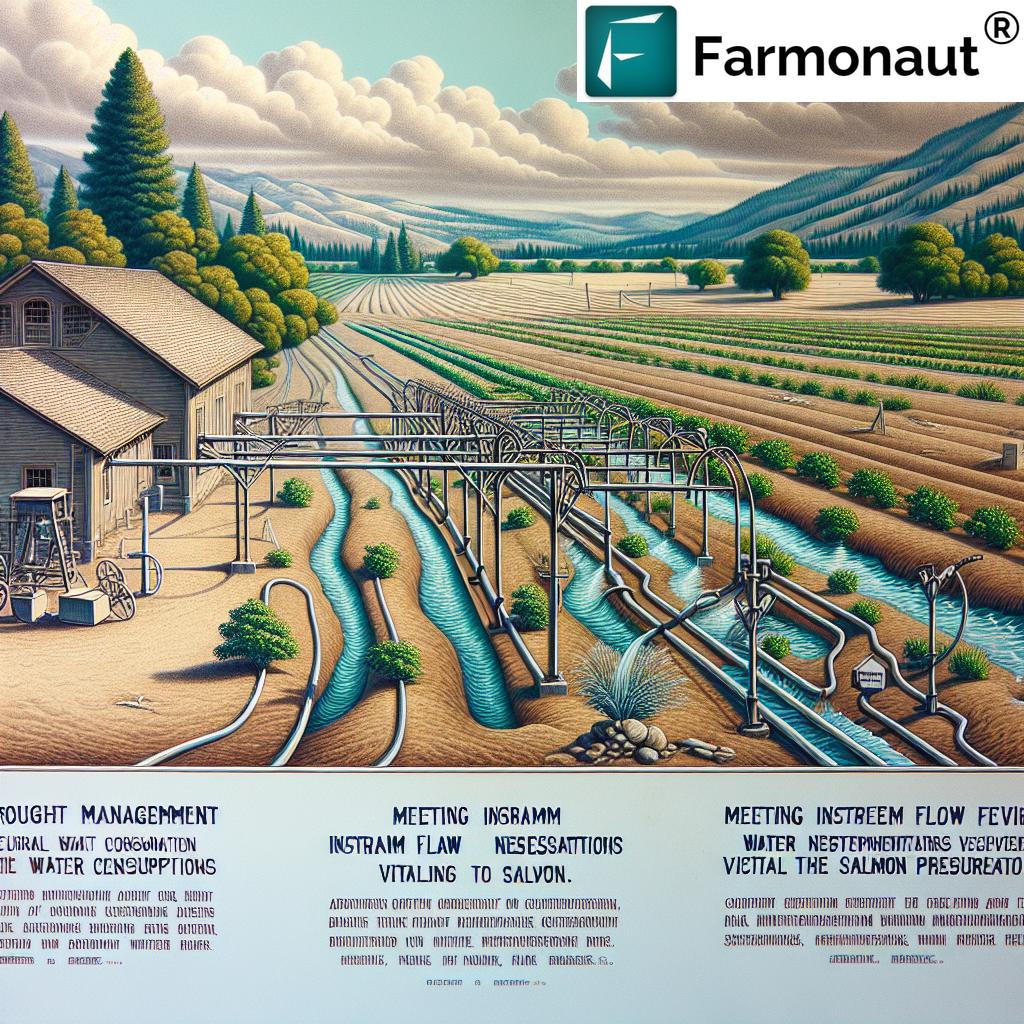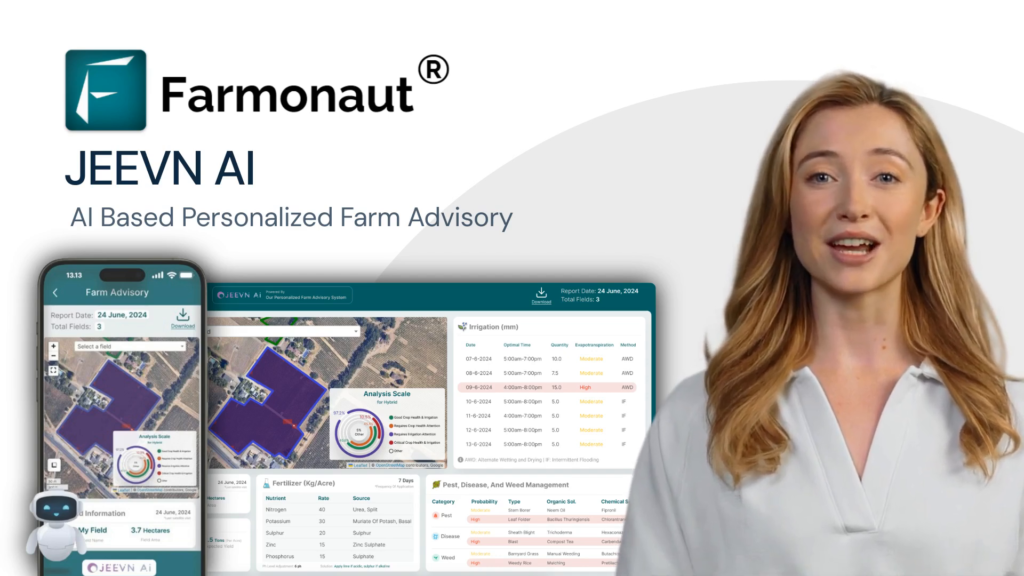5 Ways New California Water Rules Impact Klamath River Salmon
Table of Contents
- Introduction
- Legislative Context and Assembly Bill 263
- Overview of California Watershed Flow Requirements
- Comparative Impact Table: 5 Key New Water Rules
- 1. Flow Stability & Salmon Habitats
- 2. Instream Flow Requirements and Drought Management
- 3. Agricultural Water Use: Certainty & Flexibility for Farmers
- 4. Regulatory Oversight: Water Board & Local Operations
- 5. Transition from Emergency Regulations to Permanent Rules
- Farmonaut Technology & Sustainable Agriculture
- Critical Resources & Useful Links
- FAQ: Klamath River Salmon, Water Laws, and Agriculture
- Conclusion
Introduction
California’s legislative landscape for water management is evolving. As new water rules take effect, their impact extends far beyond riverbanks—directly influencing the delicate balance between agricultural production, local economies, and the survival of wildlife, especially salmon populations in the Klamath River watershed. With Assembly Bill 263 on the horizon, we must examine how california watershed flow requirements and instream flow regulations will shape the health of klamath river salmon populations, support drought response, and affect farmers’ daily operations in river-adjacent counties such as Siskiyou.
This post examines 5 crucial ways these new California water rules are changing the field—and the river. Leveraging the latest regulatory information and insights from Farmonaut’s leading-edge agricultural technology, we aim to provide clarity, actionable guidance, and a comprehensive look at one of California’s most important environmental and industry issues.
Legislative Context and Assembly Bill 263
Assembly Bill 263, introduced by Assemblymember Chris Rogers, is a direct response to longstanding concerns regarding both salmon survival and agricultural water use in california. It proposes to extend emergency drought regulations—currently applied to the Scott River and Shasta River watersheds—until permanent water flow regulations are enacted. Its aims are clear: to stabilize river flows for salmon protection while providing long-term certainty to farmers, fishermen, and regulatory bodies.
Key provisions include:
- Maintaining emergency regulations for specified watersheds up to five years.
- Ensuring a “level playing field” for all stakeholders until permanent rules are finalized.
- Mandating the Water Resources Control Board retains oversight powers to implement and adjust rules during emergencies triggered by drought conditions.
- Achieving fiscal savings for California, estimated at $2 million annually.
This legislative development, in partnership with concerned tribes and environmental alliances, is a pivotal moment for all impacted populations along the Klamath River. Both the county farm bureau and local agricultural operations have voiced strong support and significant concerns—especially over flexibility and the real impact on farm profits.
Overview of California Watershed Flow Requirements
New California watershed flow requirements strive to find a compromise between the vital needs of salmon populations and those of local agricultural operations. These rules ensure steady instream flows, adjust water extraction levels based on drought severity, and create guidelines for river flows for salmon protection.
- Scott River and Shasta River drought rules are at the center of the regulations, as these tributaries are essential spawning grounds for the Klamath River salmon populations.
- The Water Resources Control Board is empowered to extend, modify, or roll back emergency water regulations in California as drought statuses evolve.
- Instream flow requirements for the Klamath establish a framework for managing the competing needs of agriculture and fisheries—for years to come.
But what does all this mean in practice for fish, farmers, and overall drought management? The following Comparative Impact Table helps clarify each key rule’s estimated impact.
Comparative Impact Table: 5 Key New Water Rules
| Rule/Requirement | Estimated Change in River Flow (%) | Projected Impact on Salmon Population (%) | Estimated Impact on Farm Water Supply (%) | Drought Risk Level |
|---|---|---|---|---|
| 1. Emergency flow stabilization (Scott & Shasta Rivers) | +12 | +17 (spawning success rate) | -14 | Moderate |
| 2. Minimum instream flow for drought years | +8 | +10 | -7 | High |
| 3. Extraction limits for agricultural diversions | +5 | +6 | -18 | High |
| 4. Board approval for temporary flexibility | Variable* | Neutral/Situation-dependent | +3 to +10 (if approved) | Moderate |
| 5. Transition to permanent river flow rules (long-term) | +20 (after full implementation) | +25 (over 10 years) | -10 (stabilizes after 3-5 years) | Low to Moderate |
1. Flow Stability & Salmon Habitats
Securing Salmon Spawning Grounds and Life Cycles
The most immediate impact of water laws on farmers and the environment is the stabilization of flows in the Klamath, Scott, and Shasta rivers. Sudden surges or reductions in river water threaten salmon—these fish rely on predictable flows to complete their annual migration, reproduction, and juvenile development.
- Consistent Flow: The emergency water regulations california and subsequent instream flow requirements ensure river levels don’t fall below critical thresholds, especially during the driest months.
- Positive Salmon Trends: Data from regulatory reports suggest that maintaining these flows may boost annual salmon survival rates by up to 17%—a major win for local biodiversity and traditional tribal fishing rights.
- Long-Term Gains: Once permanent water flow regulations are implemented, projections indicate even greater improvements in klamath river salmon populations over the next decade.
Yet, this flow stability comes at the cost of reduced agricultural water availability, as local county farm operators have noted. The certainty provided, while valuable for planning, means less flexibility to adapt to in-season weather shifts, pest outbreaks, or rotational needs in farm management.
Transparency in Sustainability: Companies along the agricultural supply chain are increasingly required to demonstrate sustainable and ethical sourcing. This is where Farmonaut’s Product Traceability Solutions can help monitor and verify the farming and harvesting processes, supporting both regulatory compliance and consumer trust.
Optimizing Cultivation: For organizations and larger agri-operations, Crop Plantation & Forest Advisory Services offered by Farmonaut provide actionable, data-driven insights—ideal for maximizing yields under new water use restrictions.
2. Instream Flow Requirements and Drought Management
California’s new instream flow requirements klamath are designed to counter the increased frequency and severity of droughts resulting from climate change. By mandating minimum river flow rates through both normal and drought years, the board seeks to safeguard salmon even when water is scarce.
- Drought-Triggered Action: When the governor declares a state of emergency based on drought conditions, the state water resources control board can immediately enact or continue special regulations.
- Priority to Endangered Populations: The instream flow requirements prioritize maintaining aquatic habitat for endangered species—salmon being chief among them.
- Adaptive Management: The rules are structured to adapt with changing hydrological data, but extended periods of regulation (up to 5 years under AB 263) may limit rapid response to emergent needs.
For many local agricultural operations, this means greater certainty in allocation but less leeway to adjust irrigation volumes during exceptional years. As such, tools that offer real-time monitoring—such as Farmonaut’s satellite-driven crop health analytics—can give much needed risk-management capacity.
3. Agricultural Water Use: Certainty & Flexibility for Farmers
One of the most debated aspects of AB 263 is how it affects farmers. According to the president of the Siskiyou County Farm Bureau, the new rules limit flexibility to make in-season adjustments—even when new science or best practices emerge. Farmers are essentially locked into the flow requirements established in the most recent emergency regulations.
-
Pros:
- Certainty: Knowing the required river flows for the next several years enables better irrigation planning, seasonal budgeting, and risk calculation.
- Removes the surprise of last-minute regulatory changes that have often impacted profits unpredictably.
-
Cons:
- Any change in environmental or river health cannot be rapidly reflected in operational water allocations.
- Less ability to “bank” river water in good years for use during drought, reducing the adaptive capacity of county farm operations.
A detailed crop and resource management strategy is more critical than ever. Digital farm tools that provide irrigation analytics and remote field conditions (like those offered through Farmonaut’s Large Scale Farm Management) can give organizations a competitive edge, helping navigate the complexity of California’s water laws over the coming years.
Did you know? The new rules are projected to reduce farm water allocations by as much as 18% in some zones, particularly during chronic drought periods. This underscores the importance of water-saving technology and precision agriculture in sustaining farm profits.
4. Regulatory Oversight: Water Board & Local Operations
The Water Resources Control Board acts as the pivotal authority—balancing protection for endangered fish and the water needs of human communities. Under AB 263, the board retains the mandate to continue the “status quo” until permanent water flow regulations are put in place. This avoids sudden advantage to one group over another, a point Assemblyman Rogers emphasized as essential for fairness.
- Regulations must be anchored in the science of watershed health and river flows for salmon protection, but sometimes local concerns, legal challenges, and market prices nudge the regulatory field in new directions.
- For farmers, this oversight may feel restrictive, but it also removes the risk of surprise interventions during critical growing periods.
The board can, in specific cases, grant temporary flexibility or variance—especially if drought conditions worsen or new ecological data emerges. But with AB 263 on the books, that flexibility may be limited for up to 5 years before the full suite of permanent instream flow requirements klamath are enacted.
5. Transition from Emergency Regulations to Permanent Rules
Perhaps the most consequential aspect of the new rules is what happens when the emergency regulations end. AB 263 provides a bridge—maintaining the existing regulatory environment while the state develops permanent water flow regulations. This transition period is vital:
- It gives time for all stakeholders to plan, adapt, and invest in new infrastructure or conservation measures.
- Long-term impacts: Over 10 years, modeling predicts that well-crafted permanent rules could boost Klamath River salmon populations by 25% while eventually allowing for a modest (approx. 10%) recovery in agricultural water allocations as river restoration improves basin hydrology.
- Savings for the state: By avoiding the constant renewal and modification of emergency rules, budgetary stability is achieved, with potential savings of up to $10 million over the next five years.
- While stability is generally beneficial, it also places pressure on the board, farmers, and environmental advocates to get the permanent regulations right—the “middle ground” will shape the Klamath and its communities for decades.
Moving toward Carbon Neutrality: For agribusinesses under mounting pressure to reduce environmental impact, Farmonaut’s Carbon Footprinting solutions help monitor real-time emissions and achieve regulatory or market-driven sustainability goals.
Risk-proofing Investment: Unpredictable water flows increase the risk of crop failure—making insurance and crop loans increasingly vital. Farmonaut’s Crop Loan and Insurance Services use satellite verification to reduce fraud and streamline approvals.
Farmonaut Technology & Sustainable Agriculture Amid Water Regulation Changes
In an era defined by drought conditions, stricter water regulations, and evolving sustainability demands, Farmonaut is at the forefront of helping farmers and agricultural operations thrive. As a leader in affordable, scalable precision agriculture, Farmonaut integrates satellite imagery, artificial intelligence, and blockchain to drive data-informed decisions and smarter resource management.
- Satellite-Based Crop Health Monitoring: Monitor NDVI (vegetation), soil moisture, and crop stress in real-time for better irrigation, fertilization, and pest management—crucial as available water supply fluctuates.
- AI-Based Farm Advisory: Farmonaut’s Jeevn AI delivers personalized, field-specific insights and weather forecasts to increase productivity and optimize water and input use.
- Blockchain Traceability: Transparent supply chains are key to market access and proving regulatory compliance.
- Fleet and Resource Management: Efficient logistics ensure every drop of water and every gallon of fuel counts—lowering costs and environmental footprint.
- Carbon Footprinting: Demonstrate compliance with evolving carbon regulations and qualify for “green” premiums using Farmonaut’s carbon monitoring tools.
Farmonaut’s satellite/weather API and developer documentation make farm insights accessible through both easy-to-use mobile/web apps and integration with existing enterprise systems. The Farmonaut platform is designed for everyone—from smallholders planning next season’s crop to major processors adapting to new regulatory realities.
Critical Resources & Useful Links
- Farmonaut Web App: Access advanced farm monitoring and advisory tools from any device.
- Farmonaut Satellite/Weather API: Seamlessly integrate with your business dashboards.
- API Developer Docs: Start building your own agri-applications powered by Farmonaut.
- Farmonaut Large Scale Farm Management: Manage plantation, resources, and compliance with one unified system.
- Farmonaut Carbon Footprinting: Track, report, and reduce your environmental footprint with interactive dashboards and real-time emissions data.
- Farmonaut Traceability Solutions: Achieve end-to-end transparency and compliance for agricultural supply chains.
FAQ: Klamath River Salmon, Water Laws, and Agriculture
What is Assembly Bill 263, and why is it important?
AB 263 is proposed California legislation to stabilize river flow requirements in the Scott and Shasta river watersheds—both tributaries of the Klamath—until permanent water laws are enacted. It is designed to protect endangered salmon populations while providing certainty in water allocation for local agriculture.
How do emergency water regulations in California affect farmers?
Emergency regulations, extended under AB 263 for up to 5 years, limit the ability of local farmers to adjust their water use in real-time. This provides predictability but can reduce flexibility, making adaptation to new environmental or market information challenging.
What is the impact of minimum instream flow requirements on the Klamath River salmon populations?
Ensuring minimum instream flows, especially during drought, greatly increases spawning success and juvenile salmon migration survival. Experts estimate a potential 17–25% increase in salmon populations in the affected river sections over a decade.
Can agricultural operations expect future increases in available water after permanent rules are implemented?
Yes, models suggest that as river ecosystems recover, there may be a gradual recovery in agricultural water allocations—though this could happen over 3–5 years and depends on the efficacy of restoration and continued drought trends.
How does Farmonaut support adaptation to new California water rules?
Farmonaut offers a suite of satellite, AI, and blockchain-powered technologies for real-time crop monitoring, risk management, resource optimization, and regulatory compliance—empowering all sizes of operations to thrive amid changing river flow and water use requirements.
Conclusion
California’s new push for sustainable water management—anchored in watershed flow requirements, instream regulations, and the careful transition from emergency orders to permanent legal frameworks—will affect rivers, salmon, and every agricultural operation along the Klamath and its tributaries for years. While difficult trade-offs will remain, technology now offers effective solutions to support both water conservation and profitable, responsible agriculture.
With Farmonaut’s innovative agritech platform, California’s farmers, businesses, and government agencies can proactively manage changing conditions and industry demands. The road ahead is challenging—but by harnessing the power of data, real-time insight, and transparent reporting, we can ensure vibrant rural communities, resilient river ecosystems, and sustainable food production in a new era of California water law.


















